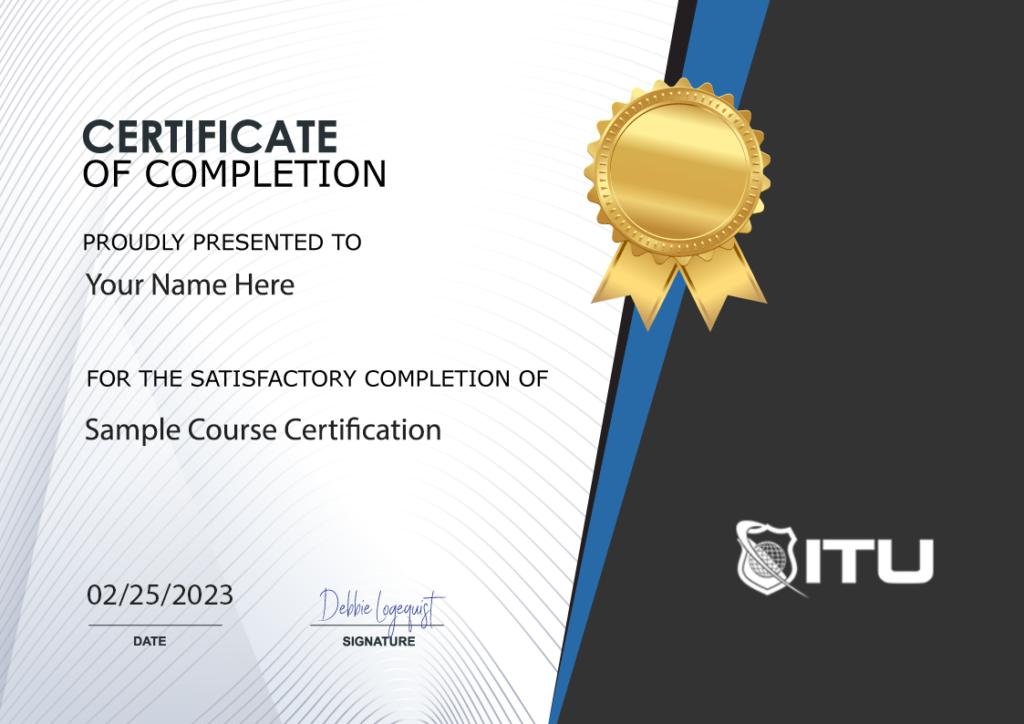Google DevOps Training Series
Become a must-have IT professional by taking this comprehensive DevOps training course geared towards the Google Cloud Platform (GCP) This comprehensive bundle includes 8 courses, along with 3 bonus courses: CompTIA Cloud Essentials and CompTIA Cloud+, and Introduction to Python.
Included In This Course



Closed Captions



Certificate of Completion
DevOps training isn’t only fun but is fast becoming a critical job function as an IT professional. This Google DevOps Training Series is geared toward the Google Cloud Platform (GCP) will best benefit programmers who want to deploy applications on GCP (the Google Cloud Platform), Cloud managers, Cloud administrators, Cloud architects, solution architects, and Cloud developers.
Embark on a Transformative Learning Journey
Join the ranks of IT professionals mastering the Google Cloud Platform (GCP) with ITU Online’s DevOps Training Online Series. This series is more than just a learning experience—it’s a crucial step towards a successful IT career in cloud computing.
Comprehensive Course Bundle for Aspiring Cloud Experts
Our 8-course bundle, enriched with three bonus courses including CompTIA Cloud Essentials, CompTIA Cloud+, and an Introduction to Python, is tailored to advance your data engineering career. Prepare for the Google Cloud Professional DevOps Engineer certification with confidence, joining the 87% of certified professionals who report increased cloud expertise.
Tailored for a Wide Range of IT Professionals
This series is ideal for programmers, cloud managers, administrators, architects, and developers focused on deploying applications on GCP. It’s an indispensable resource for anyone in IT looking to specialize in cloud-based DevOps environments.
Course Benefits: Elevate Your Career with Our DevOps Training and Certification
Fast-Track Your Success in Cloud Engineering
Gain the skills and knowledge needed to excel in cloud devops engineering. Prepare for the Google Cloud Professional Cloud DevOps Engineer exam with our targeted, in-depth training.
Maximize Performance with Site Reliability Engineering Principles
Learn how to enhance your Google Cloud infrastructure and applications. Our course focuses on monitoring, troubleshooting, and improving based on Site Reliability Engineering (SRE) principles.
Comprehensive Training for Real-World Application
With 49 hours of training, 546 on-demand videos covering 88 topics, and 357 prep questions, our course is designed to provide a thorough understanding of DevOps methodologies, perfect for IT professionals in the cloud computing field.
Who Is This Course For: Ideal Candidates for the Best DevOps Training Online
A Course for Every IT Professional
Whether you’re a programmer eager to deploy applications on GCP, a cloud manager, administrator, architect, or developer, this course is designed for you. Enhance your DevOps skills specifically for the Google Cloud Platform.
Beginner-Friendly and Advanced-Level Relevance
Suitable for both newcomers and experienced professionals in the IT sector, this series offers the knowledge and tools necessary to succeed in the fast-paced world of cloud computing and DevOps.
Broad Appeal for a Diverse Audience
ITU Online’s DevOps Training Online is a versatile and comprehensive program, ideal for IT professionals seeking to excel in cloud computing and DevOps.
Frequently Asked Questions About Google DevOps Training Series
What exactly is the Google DevOps Training Series?
The Google DevOps Training Series is a comprehensive DevOps training course that’s specifically designed for the Google Cloud Platform (GCP). This bundle includes eight main courses and three bonus ones: CompTIA Cloud Essentials, CompTIA Cloud+, and an Introduction to Python.
How many hours of training are included in this course?
The Google DevOps Training Series includes 49 hours of training. This is delivered through 546 on-demand videos covering 88 different topics. There are also 357 prep questions to help you solidify your understanding.
Who would benefit the most from this training series?
This course is perfect for programmers who want to deploy applications on GCP, as well as cloud managers, administrators, architects, solution architects, and developers. Basically, if you’re an IT professional looking to enhance your DevOps skills specifically for the Google Cloud Platform, this course is for you.
What are the benefits of taking this Google DevOps Training Series?
By taking this course, you’ll not only elevate your success in cloud DevOps engineering but also prepare yourself for the Google Cloud Professional Cloud DevOps Engineer exam. The course is designed to help you maximize the performance of your Google Cloud infrastructure and applications by teaching you monitoring, troubleshooting, and improvement approaches based on Site Reliability Engineering (SRE) principles. Plus, you’ll gain a thorough understanding of essential job skills like constructing software delivery pipelines and deploying/monitoring services on Google Cloud.
How does this course prepare me for the Google Cloud Professional DevOps Engineer certification?
The course is designed to equip you with the necessary skills and knowledge to succeed on the Google Cloud Professional DevOps Engineer certification exam. This certification is a great addition to your resume and can boost your confidence in your cloud abilities, as reported by 87% of those certified by Google Cloud.
Are there any bonus materials included in this course?
Absolutely! Along with the eight main courses, you’ll also get access to three bonus courses: CompTIA Cloud Essentials, CompTIA Cloud+, and an Introduction to Python. These extra resources will give you an even more well-rounded understanding of the cloud and DevOps.
Blogs of Interest Related to This Course
- GCP DevOps Certification: A Path to Cloud Success
- DevOps Products : A Comprehensive Guide to the Best 14 Tools and Platforms for 2024
- AWS Job Requirements : Insights into the Responsibilities and Descriptions of AWS Cloud Positions
- DevOps Training and Certification : How to Become a Certified DevOps Engineer with Online Courses and Tools
- DevOps vs Software Engineer : Understanding the Distinct Roles and Responsibilities in Tech
- DevOps Team : Mastering Tasks and Responsibilities for Organizational Impact
- Does DevOps Need Coding Skills : Decoding the Role of Programming in DevOps Practice
- How to Learn DevOps from Scratch : Starting Your Journey in DevOps with Free Resources
- DevOps Demand : Understanding Why DevOps Engineers Remain Highly Sought-After
Proudly DisplayYour Achievement
Upon completion of your training, you’ll receive a personalized certificate of completion to help validate to others your new skills.
Certified Kubernetes Administrator (CKA) Course Content
Module 1: Course Overview
- 1.1 Course Overview
- 1.2 Course PreReqs
Module 2: Kubernetes and Container Fundamentals
- 2.1 Core Concepts
- 2.2 What is the CKA Exam
- 2.3 Why Get Certified
- 2.4 CKA Exam Domains
- 2.5 What is Kubernetes
- 2.6 What is a Container
- 2.7 What is Docker
- 2.8 Kubernetes Terminology
- 2.9 Kubernetes Components
- 2.10 Kubernetes Documentation
- 2.11 Whiteboard - Kubernetes Overview
Module 3: Kubernetes Installation
- 3.1 Kubernetes Installation
- 3.2 Installation Options
- 3.3 MiniKube
- 3.4 Demo - Install Minikube
- 3.5 Demo - Clusters
- 3.6 Kubectl Basics
- 3.7 Demo - Install Kubectl
Module 4: Working with Kubernetes Clusters and Nodes
- 4.1 Working with Kubernetes Clusters and Nodes
- 4.2 Understanding the Architecture
- 4.3 Understanding the nodes
- 4.4 Core Objects
- 4.5 API
- 4.6 Create a Cluster
- 4.7 Demo - Create a Cluster
- 4.8 Demo - YAML
- 4.9 Demo - Nodes
- 4.10 Demo - Kubectl Client Config
Module 5: API Access and Commands
- 5.1 API Access and Commands
- 5.2 About the API
- 5.3 Accessing the APIs
- 5.4 Demo - Exploring APIS
- 5.5 Kubectl
- 5.6 Using YAML for API Objects
- 5.7 Using Curl
- 5.8 Labels and Annotations
Module 6: Running Pods and Deployments
- 6.1 Running Pods and Deployments
- 6.2 Pods and Deployments
- 6.3 What is a Namespace
- 6.4 Scalability Options
- 6.5 Rolling Updates
- 6.6 Apply Changes to a Pod
- 6.7 Stateful Sets
- 6.8 Demo - Manage Deployments
Module 7: Configuring Storage
- 7.1 Configuring Storage
- 7.2 Storage options with Kubernetes
- 7.3 Configure Pod Volumes
- 7.4 Configure Persistent Volumes
- 7.5 Storage Classes
- 7.6 Whiteboard - Persistent Volumes
- 7.7 Demo - Configure Storage
Module 8: Kubernetes Networking
- 8.1 Kubernetes Networking
- 8.2 Understanding Networking
- 8.3 Services
- 8.4 Network Plugins
- 8.5 DNS
- 8.6 Network Policies
- 8.7 Namespaces
- 8.8 Demo - Networking
- 8.9 Manage High Availability
Module 9: Managing Security
- 9.1 Managing Security
- 9.2 Kubernetes Security
- 9.3 Container and Pod Security
- 9.4 Certificates
- 9.5 API Security
- 9.6 Configmaps and Secrets
- 9.7 Secure Images
- 9.8 Security Context
- 9.9 RBAC
Module 10: Managing Kubernetes In the Enterprise
- 10.1 Managing Kubernetes In the Enterprise
- 10.2 Cluster Management and Maintenance
- 10.3 Demo - Scale Deployment
- 10.4 Demo - Restart Cluster
- 10.5 Demo - Add or Remove Nodes
- 10.6 Demo - Create a Pod in the Background
- 10.7 Kubelet Restarts and Drains
- 10.8 UI Dashboard
- 10.9 Demo - Describe Resources
- 10.10 Kube-scheduler
- 10.11 Demo - Set-Up Alias
Module 11: Kubernetes Monitoring and Troubleshooting
- 11.1 Kubernetes Monitoring and Troubleshooting
- 11.2 Monitoring Resources
- 11.3 Monitoring Pods
- 11.4 Demo - Monitoring Pods
- 11.5 Logging
- 11.6 Demo - Logging
- 11.7 Troubleshooting
- 11.8 Affinity and Taints
Module 12: CKA Practice Exams
- 12.1 CKA Practice Exams
- 12.2 Exam Preparation Must Know
- 12.3 Question 1 - Create a Cluster, Deploy Pods and a Deployment
- 12.4 Question 2 - Create a Pod and Verify
- 12.5 Question 3 - Create a Pod with a Secret
- 12.6 Question 4 - Get Logs on a Pod and Send to File
- 12.7 Question 5 - Liveness Probe
- 12.8 Question 6 - Use Labels
- 12.9 Additional Questions
Module 13: Course Closeout
- 13.1 Course Closeout
- 13.2 Course Review
- 13.3 Kubernetes Certifications
- 13.4 Additional Resources
- 13.5 Exam Readiness
- 13.6 Course Closeout
Certified Kubernetes Application Developer (CKAD) Course Content
Module 1: Course Overview
- 1.1 Course Overview
- 1.2 Course PreReqs
Module 2: Kubernetes and Container Fundamentals
- 2.1 Core Concepts
- 2.2 What is the CKAD Exam
- 2.3 Why Get Certified
- 2.4 CKAD Exam Domains
- 2.5 APIs
- 2.6 Demo - Explore APIS
- 2.7 Pods
- 2.8 Whiteboard - Pod Creation Workflow
- 2.9 Create a Pod
- 2.10 Lifecycle Status
- 2.11 Inspecting Pods
- 2.12 Demo - Create a Pod and Inspect
Module 3: Configuration
- 3.1 Configuration
- 3.2 Understand Configmaps
- 3.3 Understand Security Contexts
- 3.4 Demo - Create a Security Context
- 3.5 Create and Consume Secrets
- 3.6 Understand Service Accounts
- 3.7 Demo - Create a Pod to Use a Secret
- 3.8 Demo - Define a Service Account
Module 4: Multi Container Pods
- 4.1 Multi Container Pods
- 4.2 Multi Container Pods Design and Patterns
- 4.3 Ambassador Containers
- 4.4 Connecting to Pods
- 4.5 Side Cars
- 4.6 Demo - Create an Init Container
Module 5: Observability
- 5.1 Observability
- 5.2 Container Health
- 5.3 Probes
- 5.4 Logging
- 5.5 Monitor Resources and Apps
- 5.6 Monitoring Pods
- 5.7 Demo - Monitoring and Logging
Module 6: Pod Design
- 6.1 Pod Design
- 6.2 Deployments
- 6.3 Rolling Updates
- 6.4 Pod Changes
- 6.5 Jobs and Crons
- 6.6 Labels and Annotations
- 6.7 Demo - Define and Query Labels
- 6.8 Scalability Options
Module 7: Services and Networking
- 7.1 Services and Networking
- 7.2 Understanding Networking, Routing and Services
- 7.3 Network Policies
- 7.4 Namespaces
- 7.5 Demo - Networking
Module 8: State Persistence
- 8.1 State Persistence
- 8.2 Storage Options
- 8.3 Volume Storage
- 8.4 Configure Pod Volumes
- 8.5 Configure Persistent Volumes
- 8.6 Whiteboard - Persistent Volumes
Module 9: CKA Practice Exams
- 9.1 CKAD Practice Preparation
- 9.2 Exam Prep Need to Know
- 9.3 Question 1 - Create a Pod and Inspect
- 9.4 Question 2 - Define a Pods Readiness
- 9.5 Question 3 - Create a Pod with a Secret
- 9.6 Question 4 - View Pods logs in Real Time
- 9.7 Question 5 - Define and query labels
- 9.8 Additional Questions
Module 10: Course Closeout
- 10.1 Course Closeout
- 10.2 Course Summary Review
- 10.3 Kubernetes Certifications
- 10.4 Additional Resources
- 10.5 Exam Review
- 10.6 Course Closeout
DevOps Fundamentals Course Content
Module 1: Course Overview
- Course Overview
- Course Pre Reqs
Module 2: The Basics
- The Basics
- What is DevOps
- DevOps Building Blocks
- DevOps Best Practices
- Why Containers
- What is a Pipeline
- Continuous Integration and Continous Delivery
- Continuous Deployment
- Pipelines - Whiteboard
Module 3: Development
- Development Basics
- CICD Strategy
- Source Control Management
- Demo - Build Management
Module 4: Infrastructure
- Release and Deployments
- Release Management
- Demo - Release Management
- Reliability Engineering
- DevOps Tools
- Infrastructure as Code
- Automation
- Demo - (IaaC) CloudFormation
- Demo - Jenkins
- Demo - GitHub
Module 5: Key Performance Indicators (KPIs)
- Key Performance Indicators (KPI)
- KPI Metrics
- KPI Tools
- Monitoring Applications
- Demo - AWS CloudWatch
Module 6: Course Closeout
- Course Closeout
- 6.1 Module 6 Introduction
- Summary Review
- 6.2 Course Review
- Additional Resources
- 6.3 Blockchain Roles
- DevOps Job Outlook
- Course Closeout
Kubernetes - Containerizing Applications in the Cloud Course Content
Module 1: Course Overview
- Course Overview
- Course PreReqs
Module 2: Basics of Kubernetes
- Basics of Kubernetes
- What is Kubernetes
- Business Value of Kubernetes
- What is a Container
- What is Docker
- Kubernetes History
- Kuberntes Terminology
- Kubernetes Components
- Whiteboard - Kubernetes Overview
Module 3: Kubernetes Design and Architecture
- Kubernetes Design and Architecture
- Kubernetes Design Fundamentals
- Whiteboard - Kubernetes Architecture
- Deployment - Nodes, Pods, and Clusters
- Etcd
- Kubectl
- Demo - Install Kubectl
- Demo - Kubernetes Commands
- Demo - Kubernetes Commands
Module 4: Deployments
- Deployments
- Options for Deployment
- Deploying a Containerized Application
- What is Minikube
- Demo - Deploy MiniKube
- Demo - Deploy Cluster Deployment
- Demo - Deploy Services
- Demo - Manage Application
Module 5: Course Closeout
- Course Closeout
- Course Review
- Kubernetes Certifications
- Additional Resources
- Kubernetes Job Outlook
- Course Closeout
Google Cloud Platform (GCP) Certification Training Course Content
Module 1: Course Overview
- Course Overview
- Course PreReqs
Module 2: DevOps Basics
- DevOps Fundamentals
- What is DevOps
- What are Pipelines
- Continuous Integration and Delivery
- Continuous Deployment
- Whiteboard Build Services
- Demo - DevOps Services on GCP
Module 3: App Engine PaaS
- App Engine
- App Engine Basics
- App Engine Demo
- App Engine Security Scanner Demo
- App Engine or Kubenetes Engine
Module 4: Kubenetes Engine Overview
- Kubenetes Engine
- Kubernetes Basics
- What is Kubenetes Engine
- Demo - Kubenetes Engine Clusters Demo
- Kubenetes Engine Application Demo
- Kubenetes Engine Whiteboard
Module 5: DevOps Developer Tools
- DevOps Services & Tools
- Demo - Cloud SDK
- Demo - Cloud Shell
- Demo - Cloud Build
- Demo - Container Registry
- Demo - Cloud Source Repositories
- Demo - Private Catalog
- Demo - Artifact Registry
Module 6: Microservices
- Microservices
- Demo - Cloud Watch
- Cloud Functions-Cloud Run
- Demo - Cloud Functions
- Demo - Cloud Run
Module 7: Management of your DevOps Services
- Management and Monitoring
- Cloud Operations
- Demo - Cloud Operations
- Service Accounts
- Cloud Endpoints and Apigee
- Demo - Workflows and Cloud Tasks
- Demo - Recommendation Engine
- Infrastructure as Code (IaaC)
- Deployment Manager
- Demo - Deployment Manager
- Demo - Cloud Marketplace
Module 8: Resources and Closeout
- Resources and Closeout
- Course Summary
- DevOps Roles and Salary Demand
- Additional Resources
- Google Cloud Platform Certification
- Course Closeout
CompTIA Cloud Essentials+ (CLO-002) Course Content
Module 1: Understanding Cloud Computing Concepts
- Course Intro
- Understand Basic Cloud Concepts and Terms Pt 1
- Understand Basic Cloud Concepts and Terms Pt 2
- Understand Basic Cloud Concepts and Terms Activity
- Identify Cloud Network and Cloud Storage Technologies
- Identify Cloud Network and Cloud Storage Technologies Activity
- Recognize Cloud Design Aspects
- Recognize Cloud Design Aspects Activity
Module 2: Applying Cloud Business Principles
- Relate Cloud Concepts to Business Principles
- Relate Cloud Concepts to Business Principles Activity
- Establish Cloud Vendor Relations
- Establish Cloud Vendor Relations Activity
- Distinguish the Financial Aspects of Engaging a Cloud Service Provider
- Distinguish the Financial Aspects of Engaging a Cloud Service Provider Activity
- Report Financial Expenditures
- Report Financial Expenditures Activity
Module 3: Advising a Cloud Design and Migration
- Relate Cloud Concepts to Cloud Design and Migration
- Relate Cloud Concepts to Cloud Design and Migration Activity
- Use Cloud Assessments
- Use Cloud Assessments Activity
- Manage Cloud Design
- Manage Cloud Design Activity
- Compare Cloud Migration Approaches
- Compare Cloud Migration Approaches Activity
- Identity Benefits and Solutions of Cloud Services
- Identity Benefits and Solutions of Cloud Services Activity
Module 4: Operating in the Cloud
- Relate Cloud Concepts to Technical Operations
- Relate Cloud Concepts to Technical Operations Activity
- Identify the Technical Aspects of Cloud Operations
- Identify the Technical Aspects of Cloud Operations Activity
- Understand DevOps in the Cloud
- Understand DevOps in the Cloud Activity
- Explain Cloud Security Concerns, Measures, and Concepts Part 1
- Explain Cloud Security Concerns, Measures, and Concepts Part 2
- Explain Cloud Security Concerns, Measures, and Concepts Activity
Module 5: Managing Cloud Governance
- Relate Cloud Concepts to Governance
- Relate Cloud Concepts to Governance Activity
- Apply Risk Management Concepts
- Apply Risk Management Concepts Activity
- Understand Compliance and the Cloud
- Understand Compliance and the Cloud Activity
- Manage Policies and Procedures for Cloud Services
- Manage Policies and Procedures for Cloud Services Activity
Module 6: Exam Information, Review and Summary
- Exam Information
- Exam Review Pt 1
- Exam Review Pt 2
- Exam Review Pt 3
- Exam Review Pt 4
Module 7: Activities
- Apply Risk Management Concepts Activity
- Compare Cloud Migration Approaches Activity
- Distinguish the Financial Aspects of Engaging a Cloud Service Provider Activity
- Establish Cloud Vendor Relations Activity
- Explain Cloud Security Concerns, Measures, and Concepts Activity
- Identify Cloud Network and Cloud Storage Technologies Activity
- Identify the Technical Aspects of Cloud Operations Activity
- Identity Benefits and Solutions of Cloud Services Activity
- Manage Cloud Design Activity
- Manage Policies and Procedures for Cloud Services Activity
- Recognize Cloud Design Aspects Activity
- Relate Cloud Concepts to Business Principles Activity
- Relate Cloud Concepts to Cloud Design and Migration Activity
- Relate Cloud Concepts to Governance Activity
- Relate Cloud Concepts to Technical Operations Activity
- Report Financial Expenditures Activity
- Understand Basic Cloud Concepts and Terms Activity
- Understand Compliance and the Cloud Activity
- Understand DevOps in the Cloud Activity
- Use Cloud Assessments Activity
Module 8: Tools and Resources
- AWS Tools and Resources
- Azure Tools and Resources
- GCP Tools and Resources
CompTIA Cloud+ (CVO-002) Course Content
Module 1: Preparing to Deploy Cloud Solutions
- Course Introduction
- Instructor Intro
- Describe Interaction of Cloud Components and Services
- Activity Scenario Introduction
- Describe Interaction of Cloud Components and Services Activity
- Describe Interaction of Non-cloud Components and Services
- Describe Interaction of Non-cloud Components and Services Activity
- Evaluate Existing Components and Services for Cloud Deployment
- Evaluate Existing Components and Services for Cloud Deployment Activity
- Evaluate Automation and Orchestration Options
- Evaluate Automation and Orchestration Options Activity
- Prepare for Cloud Deployment
- Prepare for Cloud Deployment Activity
Module 2: Deploying a Pilot Project
- Manage Change in a Pilot Project
- Manage Change in a Pilot Project Activity
- Execute Cloud Deployment Workflow
- Execute Cloud Deployment Workflow Activity
- Complete Post-Deployment Configuration
- Complete Post-Deployment Configuration Activity
Module 3: Testing Pilot Project Deployments
- Identify Cloud Service Components for Testing
- Identify Cloud Service Components for Testing Activity
- Test for High Availability and Accessibility
- Test for High Availability and Accessibility Activity
- Perform Deployment Load Testing
- Perform Deployment Load Testing Activity
- Analyze Test Results
- Analyze Test Results Activity
Module 4: Designing a Secure and Compliant Cloud Infrastructure
- Design Cloud Infrastructure for Security
- Design Cloud Infrastructure for Security Activity
- Determine Organizational Compliance Needs
- Determine Organizational Compliance Needs Activity
Module 5: Designing and Implementing a Secure Cloud Environment
- Design Virtual Network for Cloud Deployment
- Design Virtual Network for Cloud Deployment Activity
- Determine Network Access Requirements
- Determine Network Access Requirements Activity
- Secure Networks for Cloud Interaction
- Secure Networks for Cloud Interaction Activity
- Manage Cloud Component Security
- Implement Security Technologies
- Implement Security Technologies Activity
Module 6: Planning Identity and Access Management for Cloud Deployments
- Determine Identity Management and Authentication Technologies
- Determine Identity Management and Authentication Technologies Activity
- Plan Account Management Policies for the Network and Systems
- Plan Account Management Policies for the Network and Systems Activity
- Control Access to Cloud Objects
- Control Access to Cloud Objects Activity
- Provision Accounts
- Provision Accounts Activity
Module 7: Determing CPU and Memory Sizing for Cloud Deployments
- Determine CPU Size for Cloud Deployment
- Determine CPU Size for Cloud Deployment Activity
- Determine Memory Size for Cloud Deployment
Module 8: Determing Storage Requirements for Cloud Deployments
- Determine Storage Technology Requirements
- Determine Storage Technology Requirements Activity
- Select Storage Options for Deployment
- Select Storage Options for Deployment Activity
- Determine Storage Access and Provisioning Requirements
- Determine Storage Access and Provisioning Requirements Activity
- Determine Storage Security Options
- Determine Storage Security Options Activity
Module 9: Analyzing Workload Characteristics to Ensure Successful Migration
- Determine the Type of Cloud Deployment to Perform
- Determine the Type of Cloud Deployment to Perform Activity
- Manage Virtual Machine and Container Migration
- Manage Virtual Machine and Container Migration Activity
- Manage Network, Storage, and Data Migration
- Manage Network, Storage, and Data Migration Activity
Module 10: Maintaining Cloud Systems
- Patch Cloud Systems
- Patch Cloud Systems Activity
- Design and Implement Automation and Orchestration for Maintenance
- Design and Implement Automation and Orchestration for Maintenance Activity
Module 11: Implementing Backup, Restore, Disaster Recovery, and Business Continuity Measures
- Back Up and Restore Cloud Data
- Back Up and Restore Cloud Data Activity
- Implement Disaster Recovery Plans
- Implement Disaster Recovery Plans Activity
- Implement Business Continuity Plans
- Implement Business Continuity Plans Activity
Module 12: Analyzing Cloud Systems for Performance
- Monitor Cloud Systems to Measure Performance
- Monitor Cloud Systems to Measure Performance Activity
- Optimize Cloud Systems to Meet Performance Criteria
- Optimize Cloud Systems to Meet Performance Criteria Activity
Module 13: Analyzing Cloud Systems for Anomalies and Growth Forecasting
- Monitor for Anomalies and Resource Needs
- Monitor for Anomalies and Resource Needs Activity
- Plan for Capacity
- Plan for Capacity Activity
- Create Reports on Cloud System Metrics
- Create Reports on Cloud System Metrics Activity
Module 14: Troubleshooting Deployment, Capacity, Automation, and Orchestration Issues
- Troubleshoot Deployment Issues
- Troubleshoot Deployment Issues Activity
- Troubleshoot Capacity Issues
- Troubleshoot Capacity Issues Activity
- Troubleshoot Automation and Orchestration Issues
- Troubleshoot Automation and Orchestration Issues Activity
Module 15: Troubleshooting Connectivity Issues
- Identify Connectivity Issues
- Identify Connectivity Issues Activity
- Troubleshoot Connectivity Issues
- Troubleshoot Connectivity Issues Activity
Module 16: Troubleshooting Security Issues
- Troubleshoot Identity and Access Issues
- Troubleshoot Identity and Access Issues Activity
- Troubleshoot Attacks
- Troubleshoot Attacks Activity
- Troubleshoot Other Security Issues
- Troubleshoot Other Security Issues Activity
Module 17: Exam Information, Review, and Summary
- Exam Information
- Course Review
Module 18: Activities
- Activity Scenario Introduction
- Describe Interaction of Cloud Components and Services Activity
- Describe Interaction of Non-cloud Components and Services Activity
- Evaluate Existing Components and Services for Cloud Deployment Activity
- Evaluate Automation and Orchestration Options Activity
- Prepare for Cloud Deployment Activity
- Manage Change in a Pilot Project Activity
- Execute Cloud Deployment Workflow Activity
- Complete Post-Deployment Configuration Activity
- Identify Cloud Service Components for Testing Activity
- Test for High Availability and Accessibility Activity
- Perform Deployment Load Testing Activity
- Analyze Test Results Activity
- Design Cloud Infrastructure for Security Activity
- Determine Organizational Compliance Needs Activity
- Design Virtual Network for Cloud Deployment Activity
- Determine Network Access Requirements Activity
- Secure Networks for Cloud Interaction Activity
- Implement Security Technologies Activity
- Determine Identity Management and Authentication Technologies Activity
- Plan Account Management Policies for the Network and Systems Activity
- Control Access to Cloud Objects Activity
- Provision Accounts Activity
- Determine CPU Size for Cloud Deployment Activity
- Determine Storage Technology Requirements Activity
- Select Storage Options for Deployment Activity
- Determine Storage Access and Provisioning Requirements Activity
- Determine Storage Security Options Activity
- Determine the Type of Cloud Deployment to Perform Activity
- Manage Virtual Machine and Container Migration Activity
- Manage Network, Storage, and Data Migration Activity
- Patch Cloud Systems Activity
- Design and Implement Automation and Orchestration for Maintenance Activity
- Back Up and Restore Cloud Data Activity
- Implement Disaster Recovery Plans Activity
- Implement Business Continuity Plans Activity
- Monitor Cloud Systems to Measure Performance Activity
- Optimize Cloud Systems to Meet Performance Criteria Activity
- Monitor for Anomalies and Resource Needs Activity
- Plan for Capacity Activity
- Create Reports on Cloud System Metrics Activity
- Troubleshoot Deployment Issues Activity
- Troubleshoot Capacity Issues Activity
- Troubleshoot Automation and Orchestration Issues Activity
- Identify Connectivity Issues Activity
- Troubleshoot Connectivity Issues Activity
- Troubleshoot Identity and Access Issues Activity
- Troubleshoot Attacks Activity
- Troubleshoot Other Security Issues Activity
Introduction to Python Course Content
Module 1: Getting Started with Python
- Module 1 File
- Intro to Course and Instructor
- Getting Started with Python
Module 2: Working with Primitive Data Types
- Module 2 File
- Working with Primitive Data Types
- Working with Primitive Data Types Part 2
- Working with Primitive Data Types Part 3
- Working with Primitive Data Types Part4
- Working with Primitive Data Types Part4 Answers
Module 3: Working with Multiple Assignments Statements
- Module 3 File
- Working with Multiple Assignments Statements
Module 4: Convert Types in Python
- Module 4 File
- Convert Types in Python
Module 5: Creating Lists
- Module 5 File
- Creating Lists
Module 6: Modifying Lists
- Module 6 Notes
- Modifying Lists
Module 7: Sorting and Reversing Lists
- Module 7 File
- Sorting and Reversing Lists
Module 8: Slicing Lists
- Module 8 File
- Slicing Lists
Module 9: Working With Operators
- Module 9 File
- Working With Operators
- Working With Operators Part2
- Working With Operators Part3
Module 10: Determining Operator Precedence
- Module 10 File
- Determining Operator Precedence
Module 11: Working with IF Statements
- Module 11 File
- Working with IF Statements
Module 12: Working With For Loops
- Module 12 File
- Working With For Loops
Module 13: Working With While Loops
- Module 13 File
- Working With While Loops
Module 14: Nesting for Loops
- Module 14 File
- Nesting for Loops
Module 15: Reading Files
- Module 15 File
- Reading Files Part1
- Reading Files Part2
Module 16: More on Files
- Module 16 File
- More on Files
Module 17: Merging Emails
- Module 17 File
- Merging Emails
Module 18: Reading Console Inputs and Formatting Outputs
- Module 18 File
- Reading Console Inputs and Formatting Outputs
Module 19: Reading Command Line Argument
- Module 19 File
- Reading Command Line Argument
Module 20: Defining Functions
- Module 20 File
- Defining Functions
Module 21: Using Default Argument
- Module 21 File
- Using Default Argument
Module 22: Using Keyword and Positional Arguments
- Module 22 File
- Using Keyword and Positional Arguments
Module 23: Handling Exceptions
- Module 23 File
- Handling Exceptions
Module 24: Using Math and Random Modules
- Module 24 File
- Using Math and Random Modules
Module 25: Displaying Daytime Working Directory and File Metadata
- Module 25 File
- Displaying Daytime Working Directory and File Metadata
| 5 star | 82 | 82% |
| 4 star | 17 | 17% |
| 3 star | 1 | 1% |
| 2 star | 0% | |
| 1 star | 0% |
Sorry, no reviews match your current selections
Your Training Instructors
Joe Holbrook has been in the IT field since 1993 when he was exposed to several HPUX systems on board a U.S. Navy flagship. He has migrated from UNIX world to Storage Area Networking(SAN), Enterprise Virtualization, Cloud Architectures, and now specializing in Blockchain and Cryptocurrency. He previously worked for numerous companies like HDS, 3PAR, Brocade, HP, EMC, Northrup Grumman, ViON, Ibasis.net, Chematch.com, SAIC and Siemens Nixdorf.
Currently he works as a Subject Matter Expert specializing in Enterprise Cloud and Blockchain Technologies. He is the CLO of Techcommanders.com Elearning and consulting, He holds numerous IT certifications from AWS, GCP, HDS and other organizations.
He is an avid speaker and well-known course author residing in Jacksonville, Florida.
David has been a professional IT instructor for the past four years for the US Army. He teaches a broad range of certification courses ranging from CompTIA, Microsoft to Cisco and EC-Council. Prior to working with the US Army, David worked as a Jr. Network Admin and Web Services Manager with KCTCS in Kentucky. He performed multiple jobs being on the IT team. Additionally, David taught part-time during the evening at the college, where he instructed on Active Directory, Introduction to Computers, and Networking. David has 18 years of IT experience, 17 professional IT certifications, and 8 years of teaching experience.
Dawn Briggs is an information technology professional with more than 20 years of experience in directing IT departments, leading technical implementations, managing personnel, ensuring the security of information, and establishing high customer service standards. Although she has a broad range of experience across the IT industry that includes everything from pc repair to database management, her career has primarily focused on training technical personnel to plan, implement, and maintain IT infrastructure and web-based technologies. Dawn has been instructing students in IT courses, and mentoring students in skills that allow them to obtain jobs in information technology career fields, for over seven years.

Subscribe To All-Access
Lock In $16.99 / Month Forever
Access this course and over 3,000 hours of focused IT training. Start your first month for only $1.00. Then lock in only $16.99 / month for life.
- Get Every Course
- Free Updates / New Content Added
- 3,000+ Hours of Training
- Price Lock Guarantee
- Games / Flashcards
- 21,000+ Practice Questions
$49.99 $16.99 Monthly
$49.00






good
Smooth delivery and easy access to LMS. Good to see that the LMS offers progress tracking. Would be great if badges were offered on completion of courses to share via Credly to future employers.